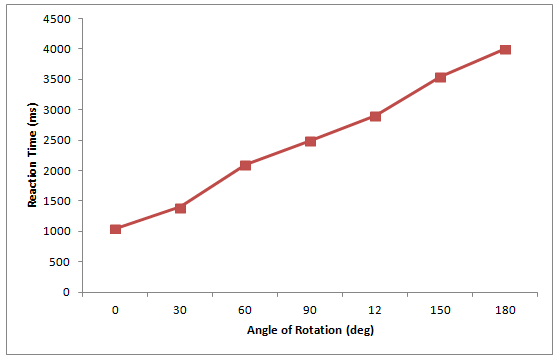Chapter 1. Mental Rotation
1.1 Introduction
Mental Rotation
In this experiment you will be asked to perform a very simple task: determine whether two images the same or not. Images will be presented to you. They will be either identical or mirror images of one another. The tricky part is that they might be in the same orientation or rotated relative to each other. You are to respond both as quickly as you can and as accurately as you can.
1.2 Experiment Setup

1.3 Instructions
Instructions
You will need to press the space bar to begin the experiment. A fixation mark will then appear in the center of the screen. Please look at this mark. After a brief period, two images will appear, one on either side of the fixation mark. The two images will be the same or mirror images of each other. Your task is to decide, quickly and accurately, if these images are the same or mirror images. You may respond by clicking on the buttons below the images or using your keyboard.
Keyboard Responses
| Key | What Response Means |
|---|---|
| f | same |
| j | mirror |
1.4 Experiment
Begin Experiment

1.5 Results
Results

1.6 Debriefing
Debriefing
This experiment is a replication of one of the more important experiments in the history of psychology. For decades, researchers thought the study of mental images was beyond the reach of science, and even questioned their very existence. Surely you have mental images. You can create in your head all sorts of scenes, real and imaginary. Still, no one knew how to develop rigorous measures that could indicate mental images existed and explain how we use and manipulate them. The measures had to be clearly interpretable and repeatable by other researchers.
Finally, Roger Shepherd, Lynn Cooper, and colleagues developed the methodology you just experienced in which they rotated two images relative to each other and measured how long it took participants to determine if the images were the same or mirror images. The results provided both a rigorous and a replicable set of findings that allowed mental images to be examined for the first time in a scientific study. What they found was that the farther apart the degree of rotation was for the two images, the more time it took to respond. But it was even more than that. Look at the figure below derived from Metzler and Shepherd (1974) with three-dimensional images.

The reaction time increased following an almost straight line. We cannot expect a much straighter line to occur. It looks like the subjects took one of the images and rotated it inside their heads until the two images were in the same orientation and then anwered. Here is clear evidence of our manipulation of mental images. In fact, it looks like we treat mental images as if they have some of the properties of real images. You can rotate or spin an object, like a top, in the real world. It seems we treat our mental images the same way.
References:
Cooper, L. (1975). Mental rotation of random two-dimensional shapes. Cognitive Psychology, 7(1), 20-43.
Cooper, L. A. & Shepard, R. N. (1973). Chronometric studies of the rotation of mental images. In W.G. Chase (Ed.), Visual information processing (pp. 75-176). New York: Academic Press.
Metzler, J. & Shepard, R. N. (1974). Transformational studies of the internal representation of three-dimensional objects. In R L. Solso (Ed.), Theories of cognitive psychology: The Loyola symposium (pp.147-202). Potomac, MD: Lawrence Erlbaum.
1.7 Quiz
Quiz